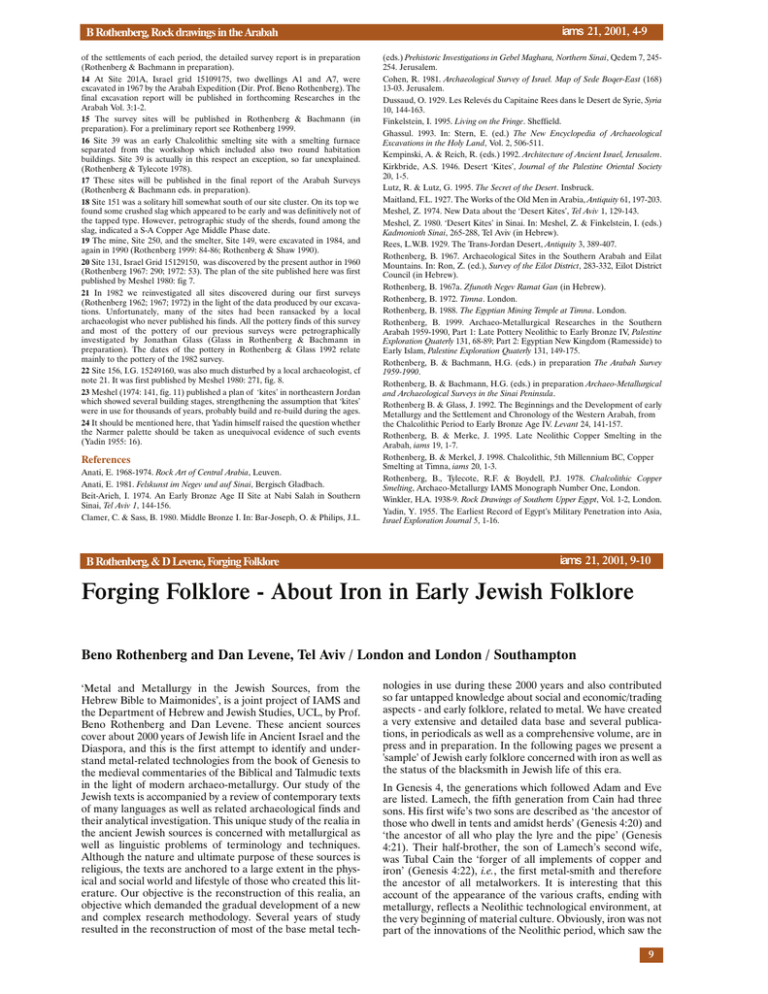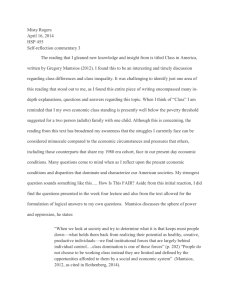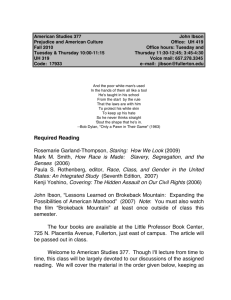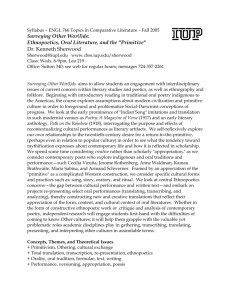Document 12866470
advertisement

B Rothenberg, Rock drawings in the Arabah of the settlements of each period, the detailed survey report is in preparation (Rothenberg & Bachmann in preparation). 14 At Site 201A, Israel grid 15109175, two dwellings A1 and A7, were excavated in 1967 by the Arabah Expedition (Dir. Prof. Beno Rothenberg). The final excavation report will be published in forthcoming Researches in the Arabah Vol. 3:1-2. 15 The survey sites will be published in Rothenberg & Bachmann (in preparation). For a preliminary report see Rothenberg 1999. 16 Site 39 was an early Chalcolithic smelting site with a smelting furnace separated from the workshop which included also two round habitation buildings. Site 39 is actually in this respect an exception, so far unexplained. (Rothenberg & Tylecote 1978). 17 These sites will be published in the final report of the Arabah Surveys (Rothenberg & Bachmann eds. in preparation). 18 Site 151 was a solitary hill somewhat south of our site cluster. On its top we found some crushed slag which appeared to be early and was definitively not of the tapped type. However, petrographic study of the sherds, found among the slag, indicated a S-A Copper Age Middle Phase date. 19 The mine, Site 250, and the smelter, Site 149, were excavated in 1984, and again in 1990 (Rothenberg 1999: 84-86; Rothenberg & Shaw 1990). 20 Site 131, Israel Grid 15129150, was discovered by the present author in 1960 (Rothenberg 1967: 290; 1972: 53). The plan of the site published here was first published by Meshel 1980: fig 7. 21 In 1982 we reinvestigated all sites discovered during our first surveys (Rothenberg 1962; 1967; 1972) in the light of the data produced by our excavations. Unfortunately, many of the sites had been ransacked by a local archaeologist who never published his finds. All the pottery finds of this survey and most of the pottery of our previous surveys were petrographically investigated by Jonathan Glass (Glass in Rothenberg & Bachmann in preparation). The dates of the pottery in Rothenberg & Glass 1992 relate mainly to the pottery of the 1982 survey. 22 Site 156, I.G. 15249160, was also much disturbed by a local archaeologist, cf note 21. It was first published by Meshel 1980: 271, fig. 8. 23 Meshel (1974: 141, fig. 11) published a plan of ‘kites’ in northeastern Jordan which showed several building stages, strengthening the assumption that ‘kites’ were in use for thousands of years, probably build and re-build during the ages. 24 It should be mentioned here, that Yadin himself raised the question whether the Narmer palette should be taken as unequivocal evidence of such events (Yadin 1955: 16). References Anati, E. 1968-1974. Rock Art of Central Arabia, Leuven. Anati, E. 1981. Felskunst im Negev und auf Sinai, Bergisch Gladbach. Beit-Arieh, I. 1974. An Early Bronze Age II Site at Nabi Salah in Southern Sinai, Tel Aviv 1, 144-156. Clamer, C. & Sass, B. 1980. Middle Bronze I. In: Bar-Joseph, O. & Philips, J.L. B Rothenberg, & D Levene, Forging Folklore iams 21, 2001, 4-9 (eds.) Prehistoric Investigations in Gebel Maghara, Northern Sinai, Qedem 7, 245254. Jerusalem. Cohen, R. 1981. Archaeological Survey of Israel. Map of Sede Boqer-East (168) 13-03. Jerusalem. Dussaud, O. 1929. Les Relevés du Capitaine Rees dans le Desert de Syrie, Syria 10, 144-163. Finkelstein, I. 1995. Living on the Fringe. Sheffield. Ghassul. 1993. In: Stern, E. (ed.) The New Encyclopedia of Archaeological Excavations in the Holy Land, Vol. 2, 506-511. Kempinski, A. & Reich, R. (eds.) 1992. Architecture of Ancient Israel, Jerusalem. Kirkbride, A.S. 1946. Desert ‘Kites’, Journal of the Palestine Oriental Society 20, 1-5. Lutz, R. & Lutz, G. 1995. The Secret of the Desert. Insbruck. Maitland, F.L. 1927. The Works of the Old Men in Arabia, Antiquity 61, 197-203. Meshel, Z. 1974. New Data about the ‘Desert Kites’, Tel Aviv 1, 129-143. Meshel, Z. 1980. ‘Desert Kites’ in Sinai. In: Meshel, Z. & Finkelstein, I. (eds.) Kadmonioth Sinai, 265-288, Tel Aviv (in Hebrew). Rees, L.W.B. 1929. The Trans-Jordan Desert, Antiquity 3, 389-407. Rothenberg, B. 1967. Archaeological Sites in the Southern Arabah and Eilat Mountains. In: Ron, Z. (ed.), Survey of the Eilot District, 283-332, Eilot District Council (in Hebrew). Rothenberg, B. 1967a. Zfunoth Negev Ramat Gan (in Hebrew). Rothenberg, B. 1972. Timna. London. Rothenberg, B. 1988. The Egyptian Mining Temple at Timna. London. Rothenberg, B. 1999. Archaeo-Metallurgical Researches in the Southern Arabah 1959-1990, Part 1: Late Pottery Neolithic to Early Bronze IV, Palestine Exploration Quaterly 131, 68-89; Part 2: Egyptian New Kingdom (Ramesside) to Early Islam, Palestine Exploration Quaterly 131, 149-175. Rothenberg, B. & Bachmann, H.G. (eds.) in preparation The Arabah Survey 1959-1990. Rothenberg, B. & Bachmann, H.G. (eds.) in preparation Archaeo-Metallurgical and Archaeological Surveys in the Sinai Peninsula. Rothenberg B. & Glass, J. 1992. The Beginnings and the Development of early Metallurgy and the Settlement and Chronology of the Western Arabah, from the Chalcolithic Period to Early Bronze Age IV. Levant 24, 141-157. Rothenberg, B. & Merke, J. 1995. Late Neolithic Copper Smelting in the Arabah, iams 19, 1-7. Rothenberg, B. & Merkel, J. 1998. Chalcolithic, 5th Millennium BC, Copper Smelting at Timna, iams 20, 1-3. Rothenberg, B., Tylecote, R.F. & Boydell, P.J. 1978. Chalcolithic Copper Smelting, Archaeo-Metallurgy IAMS Monograph Number One, London. Winkler, H.A. 1938-9. Rock Drawings of Southern Upper Egypt, Vol. 1-2, London. Yadin, Y. 1955. The Earliest Record of Egypt’s Military Penetration into Asia, Israel Exploration Journal 5, 1-16. iams 21, 2001, 9-10 Forging Folklore - About Iron in Early Jewish Folklore Beno Rothenberg and Dan Levene, Tel Aviv / London and London / Southampton ‘Metal and Metallurgy in the Jewish Sources, from the Hebrew Bible to Maimonides’, is a joint project of IAMS and the Department of Hebrew and Jewish Studies, UCL, by Prof. Beno Rothenberg and Dan Levene. These ancient sources cover about 2000 years of Jewish life in Ancient Israel and the Diaspora, and this is the first attempt to identify and understand metal-related technologies from the book of Genesis to the medieval commentaries of the Biblical and Talmudic texts in the light of modern archaeo-metallurgy. Our study of the Jewish texts is accompanied by a review of contemporary texts of many languages as well as related archaeological finds and their analytical investigation. This unique study of the realia in the ancient Jewish sources is concerned with metallurgical as well as linguistic problems of terminology and techniques. Although the nature and ultimate purpose of these sources is religious, the texts are anchored to a large extent in the physical and social world and lifestyle of those who created this literature. Our objective is the reconstruction of this realia, an objective which demanded the gradual development of a new and complex research methodology. Several years of study resulted in the reconstruction of most of the base metal tech- nologies in use during these 2000 years and also contributed so far untapped knowledge about social and economic/trading aspects - and early folklore, related to metal. We have created a very extensive and detailed data base and several publications, in periodicals as well as a comprehensive volume, are in press and in preparation. In the following pages we present a 'sample' of Jewish early folklore concerned with iron as well as the status of the blacksmith in Jewish life of this era. In Genesis 4, the generations which followed Adam and Eve are listed. Lamech, the fifth generation from Cain had three sons. His first wife’s two sons are described as ‘the ancestor of those who dwell in tents and amidst herds’ (Genesis 4:20) and ‘the ancestor of all who play the lyre and the pipe’ (Genesis 4:21). Their half-brother, the son of Lamech’s second wife, was Tubal Cain the ‘forger of all implements of copper and iron’ (Genesis 4:22), i.e., the first metal-smith and therefore the ancestor of all metalworkers. It is interesting that this account of the appearance of the various crafts, ending with metallurgy, reflects a Neolithic technological environment, at the very beginning of material culture. Obviously, iron was not part of the innovations of the Neolithic period, which saw the 9 iams 21, 2001, 9-10 B Rothenberg, & D Levene, Forging Folklore beginning of copper smelting at its very end (Rothenberg and Merkel 1995). The fact that iron was included in this description in Genesis is probably just a reflection of the fact that the final redaction of Genesis would not have been earlier than the Iron Age, when iron was already in common use and the technology of its working already at a highly developed state. Tubal Cain’s metal smithing came to be associated in later Aggadah (Bereshit Rabbah 23:22) with Cain’s primal act of murder. Whereas the latter killed without a tool, his descendant and namesake was responsible for a technological leap in the manufacture of lethal weapons. This idea is further elaborated in a story in Midrash Tanhuma (Genesis 11), which relates that as a boy Tubal Cain would go out hunting with his blind father Lamech. Acting as his eyes, he would point out the prey to his father, who upon this instigation would draw his bow and shoot. One day, the prey which Tubal Cain pointed out to his father happened to be Cain, his wandering ancestor, whom he briefly saw and mistook for an animal. Lamekh aimed and shot the arrow with fatal consequences. When he realized what he had done, he was so upset that he lost control and accidentally struck Tubal Cain, his son, on the head and killed him. Thus, Aggadah would have it that both the ancestral Cain and his descendant, the young Tubal Cain, suffered the fate of accidental death. Iron had as much impact on the spiritual as on the material culture. It was revered for its strength, which was likened to human might and power as well as erudition and sharpness of mind. It was also feared for the weapons, which could be manufactured from it. In another Midrash (Genesis R. 5 and Otsar Hamidrashim p. 253) it is written that on the third day of creation, when God introduced iron to the world, the trees, which at that time were the tallest in the land, began to tremble for they knew that they were no longer safe. God comforted the trees by reminding them, that as wood they provide the handle by which the blow of the axe is directed. This was the control they were destined to yield over iron. The awareness of the inherent fatal potential of iron is also reflected in Numbers 35:16 where it is stated that the penalty for death caused by a blow dealt with an iron object would always be death, as opposed to other materials for which a verdict of an accident could be considered. In the Mishna (Midot 3:4) it is explained that the reason for the prohibition against the use of iron tools for the making of the altar in the temple of Jerusalem was that ‘iron was created to shorten man's days and the altar was created to prolong man's days, and it is not right, therefore, that that which shortens should be lifted against that which prolongs’. This statement comes to explain I Kings 6:7 which states ‘that there was neither hammer nor axe nor any tool of iron heard in the house while it was being built.’ The Babylonian Talmud (Gittin 68) expands this motif considerably with a story about how Solomon overcame this prohibition of the use of iron in the construction of his temple. For this purpose he sought the help of Ashmedai the ‘king of demons’ whom, he was told, possessed secret knowledge of how to accomplish stone cutting without iron. To catch this powerful demon it was necessary to bind him in chains of iron; a metal considered to have the magical power to neutralize and remove the threat of demons. When bound and in captivity, Ashmedai revealed to Solomon the whereabouts of the miraculous shani worm which could be used to cut stone. Solomon was successful in his quest and managed to build his temple without the use of iron tools. Since the profession of blacksmith was not uncommon amongst the Jewish people, it is no surprise that iron entered deeply into folklore also in the Rabbinic literature. We are told that in the ‘Great Synagogue of Alexandria’ (about 250 BCE) there were five guilds which had separate seating arrangements, so that travelling Jews visiting the synagogue could join their own craftsmen and find employment. One of the guilds mentioned is that of the blacksmiths (Tosefta Sukkah 4:6, Babylonian Talmud Sukkah 51b). 10 Johanan, a famous 3rd century CE rabbi, is repeatedly referred to in the Talmud as ‘the son of the blacksmith’. Indeed, some of his comments reveal the insight of a skilled smith. Another famous second century CE rabbi called Joshua is mentioned in both, the Jerusalem and Babylonian Talmuds in a story relating an incident concerning Rabban Gamliel, the president of the Sanhedrin (the supreme Jewish political, religious and judicial body in Roman Palestine). At one time Rabban Gamliel visited R. Joshua at his house and was shocked to see that it was a blacksmith’s workshop and that he was no more than a smith. R. Joshua retorted to this insult by saying: ’Alas for the generation of which you are the leader, seeing that you know nothing of the troubles of the scholars, their struggles to support and sustain themselves!’ Maimonides, the twelfth century scholar and philosopher, also considered it important to remind his readers (Hilkhot Matanot A‘niyim 10:18) of the fact that many of the greatest sages were artisans, blacksmiths amongst them. To conclude, we have seen iron feature in Jewish folklore in a wide range of contexts. The importance of iron working in the formation of human society and the change that it affected is acknowledged by the figure of Tubal Cain, the eponymous metal smith, who is numbered amongst the first antediluvian generations. The ready availability of iron and the relative ease of carburizing and case hardening made it a popular metal for the manufacture of a whole variety of useful tools, not least of which were weapons. And so we find that it is associated with killing, both in legislation in Numbers in which its lethal quality was recognized, as well as the reasoning we find in the Talmud that explains the prohibition of the use of iron in the temple precinct that is mentioned in I Kings. In later Aggadah this deadly quality of the products of iron was expressed in the form of the tragic fate of Tubal Cain, whose craft unleashed the instruments of terror and fear. Iron was a common feature in every day utilitarian life, as in the Alexandrian synagogue the blacksmiths must have inhabited an important place amongst the guilds of other places and periods. However, as common as the use of iron was, its versatile properties which can be explained in modern scientific terms must have been a mystery to the ancient. Iron was not only a metal from which you could forge a weapon to protect yourself, people came to believe that it also possessed magical properties that could bind even the fiercest of demons. So we are told in the Talmud and other magical literature which has survived from that period. As we have stated above, the nature of the literature that we are investigating is religious. And though there is nothing within it that even resembles an artisan’s technical manual, it does, nevertheless, include a wealth of information about the material culture of the different eras in which these texts were composed. The references that we have cited here are but an expression of some of the more abstract subject matter relating to metals that occurs in this literature. The presence of iron in everyday life over a long period of time, assured it a mythical dimension in the literary imagery that represents the Israelite and later Jewish culture. This is but a scratch on the surface of an enormous corpus of literary products. In the process of our work we have also identified reference to a variety of techniques relating to the use of iron and steel, as well as other metals. We now have two articles in print (Levene & Rothenberg 2000, 2001), and another article which has been submitted for publication is titled: "Early Evidence for Steelmaking in the Judaic Sources". A number of further titles are in advanced stages of preparation. References Levene, D. & Rothenberg, B. 2000. yb’ b’_ A fundamental Aspect of the Nature of Metal", Journal for the Aramaic Bible 2, 75-87. Levene, D. & Rothenberg, B. 2001. Tin and Tin-Lead Alloys in Hebrew and Jewish Aramaic. In: Biblical Hebrew - Biblical Texts (A. Rapport-Albert & G. Greenberg, eds.) Sheffield Academic Press. Rothenberg, B. & Merkel, J. 1995, Late Neolithic Copper Smelting in the Arabah, iams 19, 1-7.






